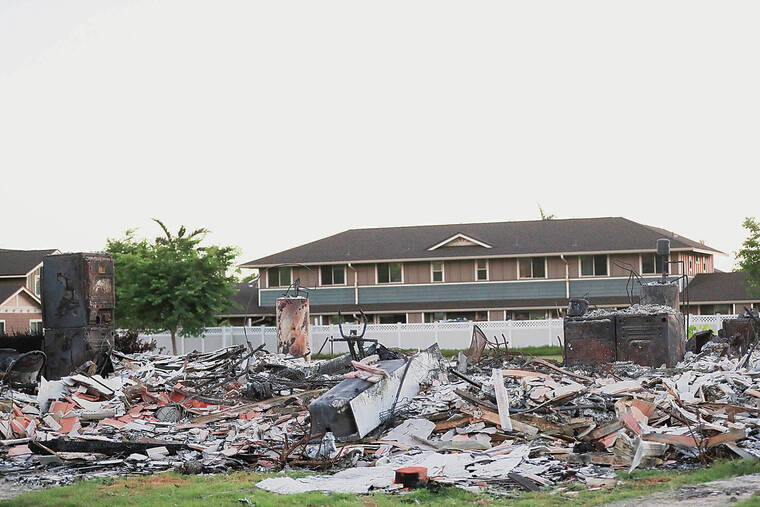
Mahalo for supporting Honolulu Star-Advertiser. Enjoy this free story!
LAHAINA >> Paul Maloney, his wife, Sandra, and their Pomeranian, Zeus, are about to move for the eighth time since the Aug. 8 wildfire that swept through Lahaina killing up to 98 people and destroying about 2,200 buildings, mostly homes.
The Kahoma Village townhome where the couple lived with the owner, their son Randall Baybayan, did not burn down in the fire as some of the other homes in the newer community. But conditions are far from normal.
Maloney said FEMA initially said the family could return to the home to live. He said it took two appeals for FEMA to conclude, as the insurance company already had, that the property was uninhabitable without power and water.
The home, which is in a burn zone, also is hard to access. To visit, the Maloneys have to go through the scrutiny of a National Guard-manned checkpoint. Outside the home, plants are dry and dying. The home’s inside reflects the chaos of a family having to flee for its life and then hastily return again and again to pick up supplies to support each new move.
“We keep having to move. It’s so tiring and we miss our family,” Maloney said during a recent supply run to the home with granddaughter Kamryn Bosque. “The uncertainty is so stressful, and we haven’t even had time to grieve. We lost three family members in the fire, and nine family members lost their homes.”
Maloney and Bosque still recall the fiercely hot flames that came within 20 yards of the townhome. Fire burned the entire block of townhomes across the street and cast cinders onto their lanai furniture. They drove north to other family homes in the Hawaiian Homelands section of West Maui and, when the flames got too close, bolted again.
Just over two months after fleeing the fire, the Maloneys and their ohana, like many other Lahaina residents, are still in limbo and facing mounting housing insecurities. They and others are coming up short as they search for mid- to longer- term rental units in a market that was already one of the nation’s tightest and most expensive before the fire. Also, the phased reopening of tourism to West Maui, which began Oct. 8, is expected to affect the availability of noncongregate shelter space in hotels and in the resort condominiums, which are more suited to longer-term stays.
The Maloneys, who first stayed with family and friends, already have had to leave two noncongregate hotel shelters. They moved from the Fairmont Kea Lani after the American Red Cross contract ended early and with little notice. The Maloneys were next assigned to a noncongregate shelter room at the Hyatt Regency Maui Resort & Spa; however, they were forced to give it up when they had to leave Maui for a few days. Maloney said the family was told that they could reapply for new shelter upon their return.
“It’s frustrating because we need a room, and we are worried about getting one when we come back,” he said. “Tourism is reopening and people are getting displaced.”
The Hyatt is in the county’s last reopening zone for its phased restart for West Maui tourism since that zone is housing most Lahaina evacuees. However, it is already advertising on its website that it will welcome guests with existing reservations Oct. 29 and is taking new reservations for stays starting Nov. 17.
The lack of available units even has hindered the nonprofit Maui Economic Opportunity’s Maui Fires Relief Transitional Housing Program, which assists fire- affected kupuna and families by paying six months of rent and a security deposit directly to the landlord. It’s a crucial gap program because it has broader qualification criteria and sometimes is able to assist those whom FEMA has denied.
MEO CEO Debbie Cabebe said the nonprofit has more applications than can be funded, and could use at least 100 more units to satisfy a waitlist of fire survivors needing housing. MEO is asking landlords or property managers with available units who would like to assist those displaced by the wildfires to initiate the process by sending a draft lease and photos of the unit to maui.fires@meoinc.org.
“It’s worse trying to find them now than before the fire,” Cabebe said. “Within the first month of the fires, we had to close applications.”
A major complication to finding longer-term housing for residents who were displaced by the Lahaina fire is that much of the housing stock in West Maui is not necessarily available to rent. Paul Brewbaker, principal of TZ Economics, said, “Maui is among those places, and West Maui specifically, with a lot of offshore investor homeownership and seasonal and other part-time occupancy.”
Brewbaker said the 2021 American Community Survey the Census estimated that there were 11,730 housing units in West Maui, with a relatively low occupancy rate of 62% and high vacancy rate of 38% because of absentee owners, turnover and the like. For the rest of Maui, the occupancy rate is 79.5%, with a vacancy rate of 20.5%. Statewide, housing units are 86% occupied and 14% vacant.
Brewbaker noted that Maui also has been extremely slow to deliver new housing stock. He said data from the state Department of Business, Economic Development and Tourism shows that Maui built about 1,100 new housing units per year from 1999 to 2007, and from 2008 to 2022 delivered about 520 new units annually.
But the lack of longer- term units in West Maui is not the only challenge getting in the way of housing more fire evacuees. Trauma as well as the trickle-down impact of the tourism downturn on Maui have caused high unemployment. Before the pandemic, Maui’s share of the GDP for tourism was 38%, according to DBEDT data.
Cabebe said without longer-term housing, people might postpone returning to work, as they don’t know where they will be living. “Thirty days in a hotel is not enough time to make a decision about what will work best for the family,” she said. “Six months at least gives some breathing room.”
Maloney said the couple has looked for longer-term rentals; however, with unemployment as their primary income, they can’t afford the few available units — especially when the cost is on top of paying half the mortgage and half the HOA fees at the Kahoma Village townhome where they rent from their son in a local- style arrangement.
Resources also are stretched. Maloney said the maximum unemployment insurance of $763 a week is not enough to live on, but just enough to put the family over the income limit for Hawaii Quest, the state’s low-income heath insurance program.
Maloney, who lost his job as an executive chef when Fleetwood’s on Front Street burned down, said he is not yet ready to find another job. His day is already too full with all of the moves, as well as waiting in line to apply for assistance, and grieving lost family members and ohana homes.
He’s also trying to be there for Bosque, whose senior year at Lahainaluna High School was disrupted by the fire, and has felt disconnected at Maui High School in Kahului, where some students don’t understand the struggle.
“I didn’t lose my home, but I lost everything that I grew up around,” Bosque said. “Some students laughed at the Lahaina kids and called us homeless. It’s crazy to hear them talk like that. I told them, ‘This is your island, you live here. You lost a part of your island, too.’”
Inadequate insurance coverage or failing to qualify for disaster assistance or enough disaster assistance also has hindered some who are looking to secure longer- term housing. Micah Kealoha, 22, had to flee the Lahaina fire, but because he was housesitting, did not qualify for federal assistance. Kealoha said people had to provide adequate proof of residency prior to the fires, which presents challenges for multigenerational families, couch surfers and the silent homeless.
“It was already pretty tricky to get a spot in Lahaina before the fire, which has only made it harder. Rents at small studio apartments were going for $2,200 before the fire and have now skyrocketed to $3,000,” Kealoha said.
Kealoha said that before the fire his goal was to save enough to move out on his own in October, but the fire-related slowdown has affected earnings from his snorkel boat job.
“I’m more fortunate than most because I can always stay with my mother in Wailuku, but there are many people in similar circumstances who are leaving Lahaina. It’s crucial to find some way to help, because the biggest reason that people loved Lahaina is because of the community,” he said.
What’s the solution? Brewbaker said getting people longer-term temporary housing and permanent housing requires that leaders “stop talking about it and just do it. There has to be a supply response, something well in excess of recent historical experience.”
“It needn’t all be rebuilt down in Lahaina town. This is actually an opportunity to rethink restoration of its historic character, but there doesn’t need to be housing right down there,” Brewbaker said. “A significant number of new units could just be built now, mauka, upslope, midlevels. The state should just finish the bypass and locate medium-density multifamily development along its extension, its alignment northward towards Napili and Kapalua, where it is supposed to have gone anyway.”
Even if Maui reaches consensus on rebuilding, based on the trajectory after other large U.S. wildfires, it could be years before Lahaina town, and its housing stock, gets rebuilt.
David Sellers, principal architect of Hawaii Off Grid, said creative solutions are needed, and as an example touted Ohana Hope Village, ohanahopevillage.com, the Family Life Center’s midterm housing project to turn a 10-acre field in Central Maui into approximately 90 homes that will house about 500 people for a few years.
Sellers, vice president and president-elect of the Maui American Institute of Architects chapter, said the needs are sobering, and based on estimates from AIA’s 400-page disaster recovery manual, rebuilding will take time. That’s why it’s critical to ensure that fire survivors have access to mid- to longer-term temporary housing, he said.
“As an architect, I’m like, we can get this built back in a couple of years, we can all come together,” Sellers said. “The reality is that within five years we can expect 25% rebuilt. That’s on average across the U.S., and those are in places like Colorado and California where you can drive a lot of supplies.”
“We are probably looking at 15 years before you go to Lahaina to visit and the first thing that you say isn’t ‘There was a fire here,’” he said.
Read More: World News | Entertainment News | Celeb News
Star Ads








